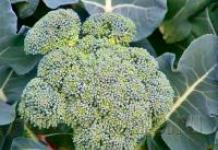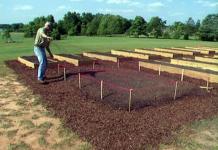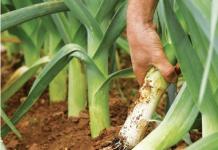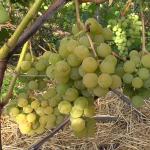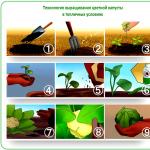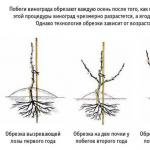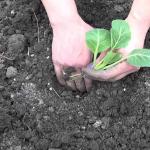Reclamation (upgrade) land is an important component of environmental management. Reclamation- this is a radical change in the components of nature to increase the consumer value (utility) of land. Reclamation leads to a fundamental long-term change in natural conditions, which persists for tens and hundreds of years.
Drainage reclamation- These are measures whose task is to regulate the water, air, thermal and nutritional regimes of an excessively moistened territory by eliminating excess water in the soil in order to increase land fertility and crop yields.
Dry mode - this is the optimal water-air regime of the soil supported by reclamation measures. It is characterized by the following main indicators: soil aeration , its humidity, dehumidification rate , critical depth of groundwater , allowable duration of flooding . Optimization of these values leads to the fact that cultivated plants receive the optimal amount of moisture, air, heat and food for them.
Dehumidification rate called the depth to which the groundwater level must be lowered from the daylight surface in order to provide optimal conditions for the development of plants. This is one of the most important characteristics of the water regime.
The optimal rate of drainage is not the same in different periods of development of cultivated plants. Usually, the following periods are distinguished for determining the rate of drainage: pre-sowing, the beginning of the growing season, the entire growing season. The average values of the dehumidification rate in accordance with SNiP 11-52-74 are shown in Table 5.
The principle of draining agricultural land - this is the principle of influencing the factors of moisturizing the root layer. It determines the choice of system design, the location of the drainage network in the plan. Depending on the path along which water is diverted from the drained area, there are five principles drainage. Each type of water supply has its own principle,
Drying method appointed based on the principle of drainage; Each principle can be answered in several ways. Thus, the dehumidification method can be understood as the practical implementation of the dehumidification principle, taking into account technical, economic and economic feasibility. The main drying methods are as follows:
at atmospheric TVP - arrangement of collectors (channels), artificial hollows, closed collectors, carrying out agro-ameliorative measures (moling, loosening the subsoil layer, ridges, etc. . d.);
with soil and soil-pressure TVP - installation of dryers (channels), drains, deep channels, discharge wells, vertical drainage;
with slope TVP - arrangement of upland channels, carrying out anti-erosion measures on the slopes;
with alluvial TVP - regulation of riverbeds (straightening, deepening, etc.), regulation of river flow (developing reservoirs, intercepting river tributaries by canals, etc.), building dams.
As a result of drainage, the moisture content in the soil decreases, and aeration increases. A change in the water-air regime affects the properties of the soil, soil processes proceed in a new direction. Drainage not only removes excess moisture, it changes soil formation and soil character.
Drying system called a complex of engineering structures and devices that create the necessary conditions for improving the water regime of waterlogged lands. The drainage system includes: drained lands, regulating, fencing and conducting networks, a water intake, hydraulic structures, a road network, forest belts, and an operational network.
The drying system consists of the following elements:
a) control network (driers, thalweg channels, furrows);
b) conducting network (transport collectors, main channels of different orders);
c) fencing network (mountain, hunting channels);
d) water receivers (rivers, large streams and lakes);
e) hydraulic structures on the regulating, conducting and enclosing network;
f) road network with transport facilities;
g) fire-fighting and environmental protection devices;
h) drained lands.
Regulatory network(dryers, collectors, vertical drainage wells) is used to collect and remove excess surface and ground water from the territory, which are the cause of waterlogging of the territory.
Fencing network(upland and hunting canals, dams) is designed to protect the drained area from surface or groundwater flowing from outside. Sometimes (with slope and alluvial TVP) the enclosing network performs the functions of a regulator.
Conductive network(main canal, collectors) connects the regulating and protective networks with the water intake, transports water outside the drained area.
water intake(river, lake, beam) is used to receive water collected from the drained area.
Hydraulic structures(locks, drops, manholes) are designed to control the flow of water during its removal or redistribution.
Road network(roads, crossings, bridges) is necessary for unhindered movement.
General patterns of melioration placement. The placement of melioration is determined by both natural and socio-economic conditions, the level of development of the productive forces of society. Soil and climatic conditions determine the need for certain melioration. Hydrological, hydrogeological and geomorphological conditions determine the possibility of land reclamation in a particular area. The complexity and sequence of their implementation. Specific methods and methods of land reclamation depend on the natural conditions and biological characteristics of agricultural crops. Zonal natural factors (climate, soil) determine the zonal nature of the location of melioration. Azonal natural factors (relief, tectonics, lithology, etc.), as well as the degree of continental climate, determine the provincial features of natural land reclamation factors. Socio-economic conditions affect both the development and the location of melioration and their efficiency. Among the economic factors influencing the placement of land reclamation measures are:
- 1) general economic (population and labor resources, the level of development and location of settlements, the level of technical progress, the state and development of transport and transport networks, specialization and concentration of production, the level of intensity of land use);
- 2) special agricultural (position in relation to settlements, water management and energy systems, enterprises processing agricultural products, agro-industrial enterprises, material resources);
- 3) the demands of the economy (expansion of agricultural production, reduction of production costs, faster payback of land reclamation costs).
The influence of the above factors determined the following regularities in the placement of land reclamation in Russia:
- 1. Drainage melioration is widespread in the northern part of the temperate zone, in areas of excessive moisture in the landscape.
- 2. Irrigation melioration is located mainly in the steppes, deserts and semi-deserts.
- 3. Anti-erosion melioration is carried out in forest-steppe and steppe landscapes.
- 4. Anti-deflation measures are practiced in deserts and semi-deserts.
- 5. Chemical reclamation has been developed in different parts of the country: gypsuming - in areas of soil salinity, liming - on acidic soils, salt-enrichment reclamation - everywhere where soil fertility is reduced.
- 6. Agroforest reclamation is more common in forest-steppe and steppe landscapes, hydroforest reclamation - in areas of excessive moisture - in Polissya, in Western Siberia.
- 7. Microclimatic amelioration is used in suburban farms. For example, growing vegetables indoors. Thermal reclamation is practiced in permafrost areas.
- 8. Snow reclamation is carried out in arid steppe and forest-steppe landscapes in order to accumulate additional moisture in spring and warm winter crops.
- 9. Specialization and concentration of agricultural production is carried out on reclaimed lands. For example, the production of vegetables in suburban farms, the production of fodder crops on drained lands in the Non-Black Earth region.
complexes of interconnected hydraulic and other structures and devices (canals, collectors, pipelines, reservoirs, dams, dams, pumping stations, water intakes, other structures and devices on reclaimed lands) that ensure the creation of optimal water, air, thermal and nutrient regimes of soils on reclaimed lands .
Federal Law No. 4-FZ of 10.01.96, Art. 2
RECLAIM SYSTEMS
according to the definition of the Federal Law "On Land Reclamation" dated December 8, 1995 "complexes of interconnected hydraulic and other structures and devices (canals, collectors, pipelines, reservoirs, dams, dams, pumping stations, water intakes, other structures and devices on reclaimed lands), ensuring the creation of optimal water, air, thermal and nutrient regimes of soils on reclaimed lands.
Ameliorative systems
complexes of interconnected hydraulic and other structures and devices (canals, collectors, pipelines, reservoirs, dams, dams, pumping stations, water intakes, other structures and devices on reclaimed lands), ensuring the creation of optimal water, air, thermal and nutrient regimes of soils on reclaimed lands ; distinguish: a) state M.s. (state-owned and providing inter-regional and (or) inter-farm water distribution and flood protection, as well as anti-erosion and pasture-protecting forest plantations that are necessary to meet state needs); b) M.s. common use (which are in common ownership of two or more persons or transferred in accordance with the established procedure for use by several citizens (individuals) and (or) legal entities, as well as protective forest plantations necessary for the needs of these persons); c) M.s. individual use (owned by a citizen (individual) or legal entity or transferred in accordance with the established procedure for use by a citizen (individual) or legal entity, as well as protective forest plantations necessary for these persons only for their needs).
Reclamation according to its effect on the soil and plants are divided into the following types.
Agrotechnical reclamation(agro-melting) - provide for a significant improvement in agronomic properties by deepening and cultivating the arable soil layer with a shallow humus horizon, a small amount of humus content and general low natural fertility. To improve the water regime of soils, special methods of tillage are carried out with the making of intermittent furrows, ridges, cracks, holes and other obstacles for snow drift and water runoff.
Forestry reclamation(forest reclamation) are carried out to improve the water regime of the soil and microclimate, as well as to protect soils from erosion by forest plantations along the boundaries of crop rotation fields, around water bodies, on steep slopes, in gullies and ravines, in areas of shifting sands and planting general forests. agronomic purposes.
Chemical reclamation provide for a radical improvement of the agrochemical and agrophysical properties of soils by using lime (on acidic soils), gypsum (on solonetzic and solonetzic soils), as well as other substances - defecation, peat, sapropel, compost, manure, green manure and other organic materials in order to enrich soils with organic substances.
Hydrotechnical reclamation(hydromelio-radiation) provide for the goal of radically improving the water regime of the territory by watering or draining.
Ameliorative system
To this end, major hydrotechnical work is being carried out to create reservoirs, irrigation and drainage systems. In the steppe arid regions, estuaries are created over large areas to retain melt water.
In the zone of insufficient moisture, various methods of irrigation (irrigation) are used, and in the zone of excessive moisture, drainage reclamation is used.
Cultural and technical reclamation- measures related to the preparation of the territory and the involvement of areas in active agricultural use (turning them into arable land) by uprooting forest clearings, clearing shrubs, destroying small forests, i.e., turning territories under natural woody vegetation into highly productive agricultural land (arable land, hayfields, pastures).
You may also be interested in:
Reclamation and its types
The concept of land reclamation
Agricultural melioration(from Latin melioratio - improvement) is a set of technical, organizational, economic and socio-economic measures aimed at radically improving adverse natural conditions in order to obtain high sustainable crop yields.
Land reclamation, reclamation and land protection is a field of science and technology that deals with purposeful improvement (amelioration), restoration (reclamation), protection of lands for various purposes, combating pollution, natural disasters - floods, flooding of lands, their erosion, erosion, landslides, mudflows , dry winds - to increase the consumer value (utility) of land.
Land reclamation is a radical improvement of land as a result of the implementation of a set of measures. Among the various types of land reclamation, the most extensive are irrigation and drainage. An important role is played by cultural work (control of shrubs, tussocks, etc.), chemical reclamation (liming and gypsuming of soils), agroforestry, strengthening of free-flowing sands, control of water and wind erosion, etc.
Land reclamation contributes to the preservation and increase of soil fertility, increase in productivity, sustainability of agriculture, mitigation of the impact of fluctuations in weather and climate conditions on production results.
Ameliorative systems
In 1966 - 1985. the area of irrigated and drained land in the country has approximately doubled. The scale of land reclamation is increasing, but the main attention at the present stage is paid to increasing its efficiency.
In recent years, irrigation and drainage have dominated the field of melioration. Insufficient attention was paid to other types of melioration. Meanwhile, unlike irrigation and drainage, non-aqueous types of melioration are less resource-intensive and often more environmentally preferable; they will receive special attention in the coming years. Great importance is also attached to improving the economic and environmental efficiency of water reclamation: the emphasis is not on the introduction of new irrigated and drained lands, but primarily on the reconstruction of previously introduced systems, on improving the culture of agriculture on reclaimed lands.
The most important role in improving the efficiency of land reclamation is played by the rational use of water.
Land reclamation is understood as a system of technical measures aimed at radically improving the unfavorable natural conditions of the used lands.
Reclamation tasks
There are three main tasks of melioration:
- improvement of lands under unfavorable conditions of the water regime, expressed either in an excess of moisture or in its lack in comparison with the amount that is considered necessary for the effective economic use of the territory;
- improvement of lands with unfavorable physical and chemical properties of soils (heavy clayey and silty soils, saline, with high acidity, etc.);
- improvement of lands subject to harmful mechanical effects, i.e. water and wind erosion, expressed in the formation of ravines, landslides, soil scattering, etc.
Types of reclamation
Depending on the specific task, various types of reclamation are used.
Reclamation, aimed at removing excess moisture from the territory, is called drainage. It finds application, in addition to agriculture, in municipal, industrial and road construction, peat extraction, when carrying out recreational activities in wetlands and other types of land development.
Land reclamation, aimed at eliminating the lack of water in the soil of agricultural fields, is called irrigation.
Land reclamation with unfavorable physical properties of soils is aimed at enhancing aeration, increasing the duty cycle and water permeability of soils. To do this, correct crop rotations are introduced, sanding of silty soils and mole drainage are used, which contribute to an increase in air and water permeability of deep soil layers.
Land reclamation with unfavorable chemical properties of soils It consists in removing harmful salts by washing, reducing soil acidity by adding lime, increasing the nutritional properties of soils with fertilizers, and introducing proper crop rotations with an increased specific gravity of grasses.
Land reclamation subject to water and wind erosion, usually includes measures aimed at reducing the amount and speed of flowing surface water, increasing soil resistance to erosion and dispersal. These activities are based on the use of a wide range of silvicultural, agrotechnical and hydrotechnical means.
Considering the importance of land reclamation issues for agriculture and the preservation of soil fertility, the main definitions of land reclamation are enshrined in the Federal Law of January 10, 1996 No. 4-FZ "On Land Reclamation".
In modern conditions, in most areas subject to land reclamation, as a rule, not one of the above types of land reclamation is carried out, but several, depending on the combination of natural and economic conditions.
So, simultaneously with the irrigation of the territory, forest belts are created on it, crop rotations are introduced on irrigated fields, fertilizers are applied, saline areas are washed, etc. in general and the hydrological regime in particular.
From the various types of land reclamation work noted above, it is obvious that many of them do not at all fall within the competence of hydraulic engineering. Among them, for example, forest reclamation, agromelioration, etc. Therefore, in the future, only those reclamation works that are usually combined into the group of so-called water reclamation will be considered, these are: irrigation, drainage and the fight against water erosion.

Water reclamation has excited the souls of people since ancient times. Irrigation canals were built by the ancient Egyptians, guessing in this way to increase soil fertility. Water reclamation (irrigation and drainage) is one of the main ways to increase the productivity of agricultural land, which occupies 10% of the planet's land area. One sixth of these lands have been reclaimed, and they receive from 40 to 50% of all agricultural products produced.
Land reclamation is an objective necessity in the transformation of natural complexes, the transformation of swamps and wetlands into highly productive agricultural lands, the social and economic transformation of the country.
Land reclamation is the most important link in the intensification of agricultural production.
Environmental aspects are inextricably linked with the economic side of the problem and require comprehensive attention and deep reflection.
In Russia and neighboring countries, the areas covered by water reclamation are constantly increasing. This leads to a significant increase in the consumption of water resources. When carrying out water reclamation, up to 200 cubic meters are annually consumed. km of water depending on the degree of moisture.
In addition, in the countries under consideration, there are practically no lands that would not need certain types of reclamation to radically improve their fertility.
The development of new agricultural land for irrigation is often hampered by a shortage of water resources, since this type of melioration is typical primarily for the southern regions of the country.
Related articles:
Definitions, goals and objectives of land reclamation
Types of reclamation
Drainage of agricultural land
Irrigation of agricultural land
Agroforestry and soil erosion control methods
Use for irrigation of desalinated sea water
 |
Back to Reclamation
Land reclamation (improvement) is an important component of environmental management.
3.1. Ameliorative systems
A person is engaged in land reclamation constantly, as soon as he switched to a settled way of life. Land reclamation is a fundamental change in the components of nature to increase the consumer value (utility) of land. Reclamation leads to a fundamental long-term change in natural conditions, which persists for tens and hundreds of years.
Since melioration is a consumer activity, a person meliorates certain territories, that is, lands. Land is a territory with land (suitable for some use), which is in someone's use, possession or ownership.
According to their purpose, they distinguish: agricultural land, or agricultural; forest fund; water fund; settlements; industry, transport, communications; health-improving, recreational, historical, cultural, scientific purposes; defense; state reserve.
Proceeding from this, they distinguish between: reclamation of agricultural lands (“agricultural reclamation”), reclamation of lands of forest, water funds, settlements, etc.
There are various types of melioration. They are classified according to the purpose and method of implementation of reclamation measures. According to the purpose of reclamation, there are: irrigation, drainage, desalination, anti-erosion. Irrigation reclamation consists in artificially moistening the soil to increase its fertility, drainage - in removing excess water from the soil, desalination - in removing excess salts harmful to agricultural crops, anti-erosion reclamation is aimed at preserving soils from destruction and washout.
According to the method of implementation, melioration is divided into hydrotechnical in the construction of hydraulic structures - canals, pipelines, water intakes, etc.; agrotechnical - ameliorative tillage, mole-growing, soil surface profiling, snow retention; forestry - planting forests; chemical - the introduction of chemicals (chemmeliorants) into the soil to improve its properties. In addition, there are cultural and technical reclamation, which consists in cleaning the surface of the soil from tree and shrub vegetation, moss tow, leveling pits, shafts and heaps, creating and cultivating the arable soil layer.
The main goal of agricultural land reclamation is the expanded reproduction of soil fertility.
The purpose of agricultural land reclamation is to expand the reproduction of soil fertility, to obtain the optimal yield of certain crops with the economical use of all resources, to prevent or compensate for damage to natural systems and other land users.
In the case of land reclamation for other purposes, the main goal may change, but the restrictions on its implementation still remain.
On the lands of the forest fund, the indicators of the reclamation regime are mainly reduced to the creation of favorable moisture in the upper soil layer, the depth of groundwater and the timing of flooding.
On the lands of settlements, industry, transport, first of all, it is necessary to ensure the required depths of groundwater to increase the bearing capacity of soils as the foundations of structures, the functioning of the underground parts of buildings and communications, the sanitary condition of the territory, to prevent the accumulation of pollutants in soils, soils and waters, to eliminate negative influence of mineralized groundwater (corrosion hazard).
On the lands of the water fund, the requirements for melioration are to improve the properties of the soils of the bottom or bed of reservoirs: the shape of the surface (leveling the banks, filling in the pits), clearing vegetation, moving cattle burial grounds, eliminating landfills, excavating peat, removing contaminated soil, silt deposits.
On the lands of recreational, historical, cultural and scientific purposes, the indicators of the reclamation regime should be reduced to sanitary and environmental requirements, ensuring the safety of valuable natural and anthropogenic objects.
Engineering reclamation systems are built on reclaimed lands, i.e. a complex of structures, devices, machines and equipment, designed together with measures to regulate the indicators of the reclamation regime.
The composition of the reclamation system depends on the type of reclamated land, the totality of regulated indicators of the reclamation regime. In general, the reclamation system includes regulatory elements that directly implement reclamation impacts, conductive and enclosing elements, sources of attracted resources, such as water, receivers of technological discharges from the reclamation area (drainage water, harmful substances, sediments, etc.).
In addition, the system includes energy supply facilities, roads, structures; means of control, communication and management.
![]()
Health Service Planning
Business management
Company management
Personnel Management
Management decisions
Back | | Up
©2009-2018 Financial Management Center. All rights reserved. Publication of materials
allowed with the obligatory indication of a link to the site.
Main page
abvgdeezhziyklmnoprstufhtschshchyyeyuyaґєії
Agroforestry land reclamation
Definitions of the expression Agroforestry land reclamation
When we find an identical definition of "Agroforestry land" we add +1 to the rating.
Sort: by rating | by date
Agroforestry is the protection of soils from drought and erosion by creating systems of shelterbelts of one design or another or, for example, draining soils using eucalyptus plantations.
Land reclamation is a radical improvement of land by carrying out hydrotechnical, agroforestry, agrotechnical and other land reclamation measures.
Land conservation is a temporary withdrawal of land from circulation in order to prevent the development and stop the processes of soil degradation, as well as restore their fertility.
Legal protection of lands is a system of measures fixed by law aimed at ensuring the rational use of lands, preserving and increasing their fertility, protection from depletion and destruction.
RECLAIM SYSTEMS
The legal regime of land is a set of legal norms that establish certain rules of conduct in relation to land, and the legal regime of a land plot is, first of all, a set of land legal relations that develop over a land plot.
Some of the lands are the lands of the Military Unit (in the middle of the island) and the weather station (North-West Cape of the island).
Purpose of lands is the procedure established by law, conditions, limit of exploitation of lands for specific purposes in accordance with the categories of lands.
About the scarcity of land, this is generally a rare nonsense, if we do not forget that Russia ranks first in the world in terms of the area of chernozems - the most fertile soils.
The reunification of historical lands sounds so beautiful!.
Types of irrigation melioration. Regular and one-time irrigation.
Agricultural melioration is a complex of technical, organizational, economic and socio-economic measures aimed at radically improving adverse natural conditions and increasing soil fertility in order to obtain high, sustainable crop yields.
Land reclamation actively influences the development of agriculture, contributes to the improvement of human life and activity. V. I. Lenin was the first to point out the enormous social significance of land reclamation. He wrote: “Irrigation is most needed and most of all will recreate the region, revive it, bury the past, strengthen the transition to socialism”*.
Melioration, changing the water regime of soils in the direction necessary for agricultural production, simultaneously affects the air, nutrient, thermal and agrobiological regimes of soils, increases their fertility and creates conditions for obtaining high and stable crop yields.
Irrigation reclamation is divided into the following types: moisturizing, watering the land, fertilizing and heating.
The most common moisturizing melioration. Their purpose is to make up for the lack of moisture in the soil or air by artificially supplying water. Moisture reclamation is used in all areas of the country where there is a permanent or temporary deficit of moisture in the soil.
Land irrigation is used in arid regions where there are no natural water sources or water flow in them is short-term and insufficient. The purpose of land irrigation is to provide water to the territory for water supply to the population, watering of livestock and for other economic and technical needs.
Fertilizer irrigation is carried out with river and waste waters (domestic, industrial and livestock effluents) simultaneously with soil moistening.
Heating irrigation is used to warm soils and plants, using the warm waters of thermal power plants, state district power plants, underground and other water sources. Heating irrigations also include special irrigations used to combat frost.
One-time or one-time irrigation is carried out by retaining spring melt water on the site (estuary) or adding water to the site during the summer flood (flood). With one-time irrigation, to create water reserves in case of drought, the soil is moistened to a depth of 1.5 ... 2 m or more. One-time irrigation does not always meet the requirements of agricultural crops, meteorological and soil conditions. It is commonly used for irrigation of meadows, pastures and crops with a short growing season. Single irrigation is an extensive way of using irrigated land and water resources.
At present, the following irrigation methods are used for regular moistening: surface gravity, sprinkling, intrasoil (subsoil), drip, finely dispersed.
8. Natural zonality of Russia. Characteristics of reclamation zones in Russia.
The zones of deserts and semi-deserts have much in common in terms of natural conditions; there is no sharp boundary between them. Their total area is about 300 million hectares. These zones are characterized by continentality, severe aridity, an abundance of light and heat. The average annual rainfall ranges from 100 to 200…250 mm. There is very little rainfall during the summer months. The average annual evaporation is 1400 ... 1700 mm and more. Natural hydration is extremely insufficient.
The temperature regime fluctuates greatly throughout the year. The average temperature in July is 26…32 °C, and in winter it decreases in some periods to -10 °C and even -30 °C. The sum of air temperatures over 10 °С is 3600…5500°. The frost-free period lasts in different regions and in different years from about 195 to 254 days.
The abundance of heat and light makes it possible to cultivate valuable heat-loving crops - cotton, rice, grapes, etc. However, these crops can be grown only with artificial irrigation. Natural moistening here is from 7 to 20% of the water consumption of agricultural crops. Therefore, irrigation in the zones of deserts and semi-deserts is the main factor in the water supply of plants.
Irrigation of lands in these zones has a number of features. Sufficient reserves of moisture from autumn and winter precipitation are not created in the soil, therefore, irrigation is necessary before sowing crops. Sometimes spring is unstable, cold and protracted, leading to reseeding of crops, that is, an unstable irrigation regime in spring. High summer temperatures and low air humidity significantly increase water consumption by plants from the fields. Therefore, frequent watering with large norms is necessary.
The areas of irrigated lands in Central Asia can be increased at the expense of their own water resources with their more efficient use. In the future, it is planned to transfer water here from Siberian rivers.
Newly irrigated lands often require drainage and salt flushing. The development of lands located high from the source of irrigation is possible under the condition of a machine lifting of water, sometimes to a considerable height) /. These lands usually have large slopes, low thickness of stony soils, and high water permeability. Irrigation of new, high-lying lands sometimes leads to flooding of old irrigated lands located below them.
At present, when designing and developing new irrigated lands, their reclamation is solved in a complex way, taking into account social factors. A vivid example of this is the Hungry Steppe, the regions of the Karakum Canal, the Karshi Steppe and other objects.
The steppe zone has a continental climate with warm summers and cold winters. The number of days with average temperatures over 10°C ranges from 180 in the west to 125 in the east. Evaporation reaches 700 ... 800 mm or more, significantly exceeding precipitation. Natural moisture in the steppe zone is unstable over the years and during the growing season. Precipitation in different years is from 40 to 90% of the total water consumption of crops. Annual rainfall decreases from west to east and from north to south; in the European part of the zone, 350 ... 500 mm falls, in the Asian - 250 ... 400 mm.
Rainfed agriculture prevails in the steppe zone. However, it is subject to droughts, which range from 20 to 30% of years or more and last from several days to 2 ... 3 months and even from spring to autumn. More frequent and prolonged are spring and early summer droughts, which are especially harmful to spring sowing crops. Therefore, to increase the yield of agricultural crops, moisture accumulation in the soil due to autumn, winter and spring precipitation as a result of agrotechnical and reclamation measures is essential. Irrigation in the steppe zone only supplements the missing natural precipitation. It also contributes to their more efficient use.
Irrigation here is sometimes sparse (selective). Regular and one-time (estuary) irrigation using local spring runoff is widespread. In recent years, irrigation has begun to develop in large areas using the flow of large1 rivers - the Volga, Don, Dnieper, Dniester, Terek, Kuban, etc. The most rational here is the irrigation of orchards, sugar beet, vegetables, melons, grain and fodder crops.
In many areas of the steppe zone, water erosion of soils is highly developed, leading to rapid siltation of ponds, drying up the soil when ravines form, and hindering the mechanization of field work.
The forest zone extends from the Baltic Sea to the Sea of Okhotsk and the Sea of Japan. The climate of the zone in the European part is moderately humid, in Siberia it is sharply continental, where frosts reach -50 °C, and summer temperatures can exceed 30 °C. The average annual rainfall is 450 ... 650 mm, and on the Pacific coast - up to 800 mm. Evaporation from the water surface in the eastern part of the USSR is 300 ... 400 mm, increasing in the west to 400 ... 600 mm or more. Consequently, on average, precipitation is approximately equal to evaporation, and in some areas (in the north-west of the zone) exceed it.
Agriculture is developed throughout the forest zone. The further development of agriculture should be linked with the rational management of forestry. In areas where there is excessive natural moisture and there is no surface or groundwater runoff, drainage reclamation is required. However, in many regions there are periods in the summer when precipitation does not fall for a long time and such moisture-loving crops as vegetables, fodder and grasses need artificial soil moisture.
In the forest zone, a sufficient amount of moisture is usually created in the soil by the spring, but there are some years when these reserves are insufficient.
Reclamation
Dry periods in summer occur at different times and for varying durations. Practice shows that even in the area of excessive moisture, vegetable crops experience a lack of moisture in spring and early summer, on average, once every two years. Irrigation of crops during dry periods significantly increases their yields.
In the forest zone, irrigation is episodic: in some dry periods, valuable moisture-loving crops are watered, and usually in small areas1. In recent years, irrigation has begun to develop in vegetable and livestock farms near large cities and industrial towns. Wastewater is also used for irrigation: domestic, industrial enterprises and livestock complexes. Irrigation of cultivated pastures and meadows is being developed.
In the forest zone, there are areas with insufficient precipitation in the summer, where water consumption exceeds precipitation and available moisture reserves in the soil. Obviously, irrigation will develop here in connection with the rapid growth of the population, which must be provided with vegetables and other products through production in local conditions. The development of greenhouse farms in the forest dawn is promising. The main method of irrigation in the forest zone is sprinkling.
The use of land for agricultural purposes does not lose its relevance even in the age of high technology. However, the effective use of soil for growing cultivated plants is possible only if it meets the necessary agrotechnical characteristics. There are practically no lands that are initially ready to provide a high yield after sowing without appropriate preparation. Reclamation of agricultural land allows to achieve the optimal result in the process of soil exploitation, during which the quality of the cultivated area improves. We are talking not only about a direct increase in the productivity of the soil layer, but also about the rationalization of land from the point of view of further use for agricultural needs.
What is melioration?
Land reclamation is understood as a whole range of measures aimed at increasing the productivity of land in terms of increasing productivity. This is achieved through the use of organizational, technical and economic measures, as a result of which the soil properties are improved. At the same time, there are different types of reclamation that increase specific characteristics. This may be, for example, a set of measures to improve the soil layer, which has undergone excessive oxidation.
Land reclamation operations are widespread not only in the professional agricultural sector, but also in the field of private gardening. For example, it may be the regular cultivation of a summer cottage or garden. But in this case, an intensive and long-term impact on the land is important, since reclamation is a system of agricultural practices, the implementation of which radically and for the better changes the state of the soil.
Land hydromelioration

This is one of the most common types of reclamation work, which is used both in specialized farms and ordinary summer residents. Hydromelioration involves improving the condition of soils through water or air exposure. These measures are used in the processing of excessively moist, swampy, eroded, arid and washed-out lands. In such cases, the main types of reclamation are usually used, which normalize the water, thermal and nutrient regimes of the soil. The most popular types of hydromelioration include drainage, irrigation, anti-erosion, anti-flood and anti-mudflow measures. The prevalence of this area of agricultural prevention is due to the resources used. In particular, water and heat with air are the primary components on which soil productivity depends.
Agroforestry land reclamation
Activities of this type involve the use of soil-protective and water-regulating properties of the forest. In other words, agroforestry aims precisely at providing protective barriers, the formation of which also occurs in different ways. For example, anti-erosion reclamation is agrotechnical measures aimed at protecting the soil from erosion with the help of forest plantations. In this case, trees are planted in the areas of beams, ravines, river banks, etc. Another area of agroforestry is field protection measures. In this case, it is supposed to provide protection from adverse factors of various origins. For example, from anthropogenic, natural and man-made phenomena. Land protection is also achieved through forest plantations, which are formed along the boundaries of agricultural plots.

Chemical land reclamation
With the help of chemical applications, the mineral composition of the soil layer is improved. But such measures should be carried out only in the case of unsuitable or initially unsuitable lands. In the process of chemical reclamation, elements harmful to vegetation are removed from the soil, and the earth is also enriched with useful components. Various types of melioration of this type are used, including liming, acidification and gypsum. The first option is used to enrich non-chernozem lands with lime fertilizers. Gypsum additives are used in solonetzes to reduce alkalinity in the soil composition. Land acidification is practiced less often, but in the case of tea cultivation, this method of reclamation is the most effective.
Thermal soil reclamation

This reclamation technique can be attributed to seasonal methods, since it is used mainly in winter. The main task of such events is to ensure the optimal thermal regime for the soil. Work is carried out before frosts in order to increase the temperature of the deep and surface layers so that the roots of plants receive protection from the cold passing through the soil. This is achieved in various ways, including the introduction of mineral soil. Classical thermal reclamation is mulching, which is carried out by laying out compost on the ground. This is the simplest method of insulation, for which various materials can be used. Even in a small farm, you can find raw materials for mulching - in particular, sawdust, shavings, leaves, litter, and other waste are used.
Cultural technical melioration
This type of treatment can be called surface, since it does not imply an invasion of the soil structure and its chemical composition. As a rule, cultural and technical measures on the ground come down to ridding the area of foreign objects - these can be weeds, stones, stumps and other objects that interfere with the direct use of the land. Cleaning can be done both manually and with the help of special equipment. For example, cultural and technical land reclamation may involve loosening by cultivators and sanding. Such work allows you to protect the soil from overgrowing with weeds and increase its resistance to pests.
Forest reclamation

Measures have already been noted that use forest plantations as a tool for soil protection. But this measure can be used as an independent method of melioration. The fact is that artificial and natural forest belts are able to effectively regulate water flows. For this reason, lands in forest areas are practically not subject to erosion processes. This characteristic is especially appreciated in large agricultural enterprises and farms where a water regulating component is needed. It can be said that forest reclamation is an auxiliary factor that allows creating favorable hydrotechnical conditions for the soil on an ongoing basis.
What factors influence the choice of melioration?

There are many aspects on the basis of which the application of one or another method of melioration is determined. First of all, this is the initial state of the soil. The same operations of oxidation or liming are carried out only in cases where the earth requires additional nutrition or restoration against the background of a chemical imbalance. In other words, depending on the current situation, experts determine which types of melioration are appropriate to use in this case. External factors are no less important - the presence of a forest belt and climatic conditions can add or correct the choice of agrotechnical measures. An analysis of the needs for improving the operational properties of the soil is not complete without taking into account the specifics of future land use. For each crop, its own soil composition indicators are important.
Conclusion

Reclamation work cannot be called something new for agriculture. Perhaps this is one of the oldest activities of man, who cultivated the land and already in antiquity understood the importance of fertile soil. Another thing is that modern soil reclamation involves the use of technically advanced tools and special equipment. With the help of productive units, agricultural workers perform irrigation, cultivation, chemical treatment, fertilizer and other activities. At the same time, there is a place for folk remedies for land reclamation, including mulching, loosening, clearing and all kinds of ways to protect the land cover from unwanted external influences.
Land reclamation is all types of work that are aimed at improving the soil and its greater return in order to obtain benefits for humans. As a rule, these works are really closely related to agriculture, therefore quite impressive means and various methods are used in this direction. They may include both soil enrichment, and in making it suitable for use in order to obtain a crop, that is, to cleanse and level the landscape.
However, these methods should not be confused with soil drainage.
If drying them leads to the fact that the environment may eventually suffer, then reclamation always implies a close relationship with the safety of all natural reserves and systems, both in the cultivated and adjacent areas.
As a rule, land reclamation is reduced to the development of garden and crop plots. It can also be carried out to improve the soil after its long-term use for agricultural purposes.
Quite often, these methods are used when the soil is subject to the destructive influence of various natural factors. In any case, land reclamation does not include exclusively operational methods, but is a means increasing soil productivity without any negative environmental impact.
Soil reclamation in a certain area can be carried out for quite a long time. But its consequences for nature and people persist much longer, that is, for tens or even hundreds of years.

What are the types?
Land reclamation may include organizational, economic and technical measures. Competent logistics in the implementation of all work also plays an important role. In addition, only high-level specialists can determine the need for the implementation of certain methods and their further impact on the environment.
How exactly all land reclamation work will be carried out depends on two factors:
- the initial state of the treated area;
- What is the purpose of the reclamation?
Main types of land reclamation lands are:
- hydromelioration;
- agroforestry;
- cultural melioration;
- chemical soil reclamation.

Hydrotechnical reclamation
It is carried out in cases where it is necessary to stabilize the water enrichment of soils and their optimal moisture. Methods of hydrotechnical or water reclamation of agricultural lands are designed to eliminate excess moisture in those areas where it is necessary, as well as to enrich dry areas with moisture.
Water, air, thermal and nutrient regimes are brought back to normal, which ensures increased soil fertility and their best performance in all respects.
Most Popular hydromelioration methods- It is a dehumidifier and an irrigation.
Drainage melioration It comes down to reducing the excess moisture level in the cultivated area to the norm. The optimal indicator of moisture in the soil is mainly achieved by lowering the level of groundwater. The dehumidification rate determines the level of their decrease to the indicator that will provide the most favorable conditions for plants. To do this, groundwater is diverted from the root layer along other paths, according to a specific plan.
essence irrigation is the opposite. All irrigation reclamation measures are to increase the level of moisture in those areas that lack natural water resources. In particular, all works optimize atmospheric, soil and hydrological parameters. That is, this is the irrigation of the territory in order to increase its fertility.
Land reclamation can be done with your own hands - watch an interesting video.
Cultural technical melioration
It is carried out in cases where the soil or plot is simply needed clear unwanted items. It can include a huge range of different works. But they all boil down to increasing the "usefulness" of the soil, or making it suitable for cultivation.
This type of soil improvement makes it necessary to periodically carry out even in constantly cultivated fields, as they become clogged with stones and unwanted plants over time. This leads to a decrease in soil yield, damage to agricultural machinery parts and improper harvesting, since the content of stones in the soil makes harvesting on elevated stems. And the overgrowing of the territory with weed plants significantly reduces its usable area.
Also, various works on cleaning and optimization of the territory are carried out in order to improve the conditions of unsuitable for agriculture areas. For this, land is cleared of unwanted vegetation, stumps, bumps, stones. Also loosening, sanding the soil, as well as other land reclamation works.
Chemical reclamation
This type of land reclamation and all the work on its implementation come down to improving the chemical and mineral composition of the soil, which is initially unsuitable or unsuitable for good yield indicators.
The main types of chemical reclamation, firstly, ensure the removal of chemicals harmful to plants from the soil, and secondly, enrich it with useful elements.
However, there are three most common chemical reclamation method, such as:
- Liming(enrichment of the soil with lime fertilizers). Basically, this method is used for non-chernozem soils;
- plastering(gypsum is introduced into the soil, which lowers the alkalinity of its composition). The method is relevant for salt licks;
- acidification(the soil is acidified) Most often, the soil on which tea is planned to be grown needs this method.
In addition, almost every soil needs to be enriched with chemical fertilizers. This type of agricultural work also refers to one of the methods of chemical land reclamation.
